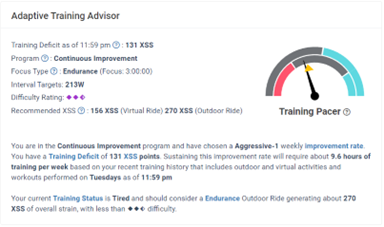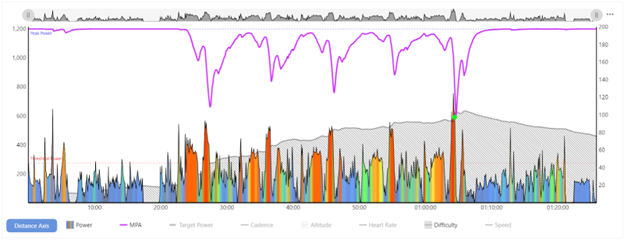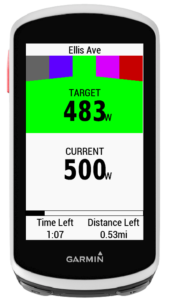Cycling is a fantastic way to improve cardiovascular health, build endurance, and strengthen muscles. Whether you’re a casual rider or a seasoned cyclist, the pursuit of improved fitness is a constant endeavor. For many athletes, the winter months provide a time for athletes to follow a methodological, structured training program, typically leveraging the usefulness of direct drive smart trainers. However, as warmer weather returns, many athletes are eager to ditch the turbo and enjoy the fresh air & sunshine.
While structured workouts on the turbo can provide a focused approach to fitness improvement, not everyone has the time or inclination to follow a strict regimen. The good news is that rigid training programs are not the only path to enhancing your cycling fitness – you can continue enhancing your cycling fitness without structured training by incorporating several strategies into your routine. In this blog post, we’ll explore how Xert can help you continue improving your fitness on the bike, even without a strict regimen. Let’s explore some key strategies below!
Progressive Overload

Perhaps the most fundamental rule to fitness is progressive overload, or the gradual increase in training duration and/or intensity. By progressively increasing the demands placed on the body, such as cycling longer distances or riding at higher intensities, you force your muscles, cardiovascular system, and other physiological systems to adapt and become stronger, more efficient, and better equipped to handle the increased workload. Lastly, progressive overload is the key to preventing fitness plateaus. Whether you’re a relatively new athlete, or have years of riding experience, incorporating progressive overload into your routine is key to increasing your cycling strength & endurance. Riders should be aware that as your training volume increases, like moving from 2-stars to 4+ stars, progressive overload becomes more challenging, as your required training time will continue to increase.

Consistency is key to progressive overload. Make a commitment to regularly get on your bike and maintain a consistent riding schedule. Whether it’s a few times a week or daily, staying in the saddle keeps your body engaged and accustomed to the demands of cycling. Xert keeps users accountable via the Adaptive Training Advisor (XATA). It uses your own training history plus your selected Improvement Rate to recommend training that progressively improves your fitness.
Balance Training & Recovery
While it’s true that progressive overload is the fundamental basis for fitness improvement, rest and recovery are vital for avoiding burnout and facilitate adaptations and improvement. Balancing progressive overload with recovery is a dynamic process that requires attentiveness and flexibility. Fortunately, Xert is a handy tool for athletes looking to optimize that balance!

By tracking your fitness & recovery demands across all your body’s energy systems, Xert can provide improved insight into the training you should consider each day. Adding too much training in a short period of time will likely result in a Very Tired (Red Star) status, indicating that you should consider a recovery day. After a hard group ride or race, your training status is likely Tired (Yellow Star), indicating that your high-intensity and/or sprint systems need recovery, but that your low-intensity system is still ready to handle more training. On these days, Xert will recommend low-intensity endurance training for you. Lastly, on days when you are fresh & ready to go, Xert will recommend harder training!
Varied Routes
Exploring different routes and terrains not only adds excitement to your rides but also challenges your body in new ways. Seek out hills or gravel roads – if you have a gravel bike – to engage different muscle groups and improve overall strength and endurance. Embrace the diversity that cycling offers!
Not all routes are created equal – some routes might be beneficial for an endurance/recovery ride, while other routes might be useful for pushing yourself! Further, riding the same route repeatedly can become monotonous and lead to a decline in motivation. Exploring new routes brings a sense of adventure and excitement to your cycling experience. Discovering new roads, scenic views, and interesting landmarks not only keeps your mind engaged but also boosts your overall enjoyment of cycling. A positive mindset and increased motivation contribute to better fitness gains as you’re more likely to push yourself and stay consistent with your training.
By varying your cycling routes, you keep your workouts fresh, engaging, and challenging. The combination of different terrains, intensity levels, and mental stimulation contributes to improved fitness gains, skill development, and overall enjoyment of cycling. So, explore new routes, embrace the adventure, and let your cycling journey take you to new heights of fitness and accomplishment.
Did you know? Xert will recommend your unstructured rides as part of your dynamic training program. This means you can progress towards your training goals even if you prefer riding outdoors over doing intervals on the turbo!
Read more about Recommended XSS, here.

Group Rides
Joining local cycling groups or clubs can provide motivation, camaraderie, and a chance to ride with more experienced cyclists. Group rides often involve higher speeds or longer distances, pushing you to new limits. These types of hard group rides are an excellent way to add additional strain (XSS) to maintain progressive overload. Riding alongside others can inspire friendly competition and drive you to achieve more.
To learn more about Group Ride Analytics featuring fly-by’s check out this article, here.
Intervals and Sprints
Interval training and sprints are excellent tools for improving fitness. Incorporate short bursts of high-intensity efforts during your rides. Choose specific landmarks or time intervals and push yourself to higher intensities. This simulates the benefits of structured interval training and enhances your cardiovascular capacity. For many athletes, hill repeats are a common outdoor workout.

One of the many features that Xerters love having on-board their head unit is Maximal Power Available (MPA) data. Xerters can know in real-time exactly how hard they need to work to generate a Breakthrough, whether that involves a townsign sprint, a hard effort up a punchy climb, or a longer, drawn-out effort, such as a Time Trial.
Xert’s Recommended Training
While many athletes might not think that unstructured rides are training, Xert might say that’s actually not the case! Oftentimes unstructured workouts, like hill repeats, or hard efforts during group rides can provide an excellent training stimulus! Using your second-by-second MPA, Xert can accurately quantify the training strain accumulated during unstructured rides, which allows us to easily compare them to structured workouts.
Consider the activity shown below – a simulated race – which features approximately 120 XSS at a Puncheur (4 min power) focus:

This activity provides similar training strain (XSS) at a particular focus to some of the SMART workouts in the Xert library, such as SMART – One Step Closer and SMART – Headstrong – 90, both shown below:
Using that information, one could argue that this group simulated race provides the same training benefit as the workouts listed above, but provides an athlete the opportunity to work on other skills, like riding in a group or holding a wheel, while also providing a great training session!

Many times, group rides or unstructured rides provide opportunities to train more or train harder than you might consider when grinding intervals on the turbo or doing solo workouts outdoors! Remembering that progressive overload is the foundation for improvements in fitness, rides that push you outside your comfort zone can be highly beneficial for your fitness – when paired with adequate recovery, of course!

Goal Setting
Establishing realistic goals for yourself provides a sense of purpose and motivation. It can be as simple as completing a certain distance, conquering a challenging climb, or participating in a cycling event. Setting and working toward goals gives structure to your cycling endeavors and keeps you focused and driven.
Xerters with a compatible Garmin Edge device can also leverage the power of the Xert Segment Hunter (XSH) data field to ‘hunt’ their favourite segments, aiming for a Personal Record (PR) or King/Queen of the Mountain (KOM/QOM). XSH uses your unique fitness signature & your real-time MPA to pace your power effort across a Strava segment at your maximum potential.
For more information see the XSH quick start guide, read our support article, here.
Conclusion
Structured training programs may not be suitable or appealing to all cyclists. Fortunately, there are several effective strategies to continue improving your cycling fitness without formal training. By incorporating consistent riding, adequate recovery, varied routes, intervals, group rides, and goal setting into your routine, you can keep pedaling forward and reap the benefits of an active cycling lifestyle. Remember to listen to your body, embrace the joy of cycling, and adapt your approach as needed. Enjoy the journey, and let the wheels keep spinning you toward greater fitness!








